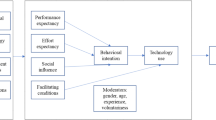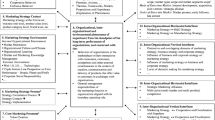Abstract
The implementation of sales force automation applications (SFA) often fails owing to the lack of adoption by salespeople. Previous studies investigating drivers of salespeople’s SFA adoption have mainly scrutinized predictors on the level of salespeople (within-level analysis). Hence, these studies have mostly neglected the social influence of coworkers’ and superiors’ SFA adoption on salespeople’s SFA adoption. We introduce a new perspective using a multilevel framework of SFA adoption at several hierarchical levels. The findings demonstrate that coworkers’ and superiors’ SFA adoption has a positive effect on subordinates’ SFA adoption which goes beyond the commonly tested determinants. Also, results reveal differences among predictors of the Technology Acceptance Model (within-level effects) examined at three different hierarchical levels.

Similar content being viewed by others
Notes
Our theory and empirical models assume a unidirectional causal relationship between the sales manager’s SFA adoption and salespeople’s SFA adoption. To test the possibility of reversed causality we calculated a nonrecursive model with both paths tested simultaneously. This procedure is applicable if there is an additional exogenous variable that correlates with one of the predictors and not with the other (Kline 2005). In principle, any variable that explains variance in the one but not the other latent factor can be used. Organizational identification of the manager (we used one item “When I talk about [organization’s name], I usually say ‘we’ rather than ‘they’”) proved to be such a variable; it was significantly related to sales manager’s SFA adoption but not to salespeople’s SFA adoption. Using AMOS 16.0 we calculated a model with sales manager’s SFA adoption and salespeople’s SFA adoption as latent variables. Finally, we entered organizational identification of the manager as the additional exogenous variable. As predicted, the path from sales manager’s SFA adoption to salespeople’s SFA adoption was significantly larger (ß = .38, p < .01), than the opposite path (ß = .04, n.s.). Finally, a model with a path from sales manager’s SFA adoption to salespeople’s SFA adoption fits much better than one with a path from salespeople’s SFA adoption to sales manager’s SFA adoption (1, Δχ2 = 7,97).
References
Ahearne, M., Jelinek, R., & Rapp, A. (2005). Moving beyond the direct effect of SFA adoption on salesperson performance: Training and support as key moderating factors. Industrial Marketing Management, 34(4), 379–388.
Ahearne, M., Jones, E., Rapp, A., & Mathieu, J. (2008). High touch through high tech: The impact of salesperson technology usage on sales performance via mediating mechanisms. Management Science, 54(4), 671–685.
Armstrong, J. S., & Overton, T. S. (1977). Estimating nonresponse bias in mail surveys. Journal of Marketing Research, 14(3), 396–402.
Arnold, J. A., Arad, S., Rhoades, J. A., & Drasgow, F. (2000). The empowering leadership questionnaire: The construction and validation of a new scale of measuring leader behavior. Journal of Organizational Behavior, 21(3), 249–269.
Avlonitis, G. J., & Panagopoulos, N. G. (2005). Antecedents and consequences of CRM technology acceptance in the sales force. Industrial Marketing Management, 34(4), 355–368.
Bandura, A. (1977). Social learning theory. Englewood Cliffs: Prentice-Hall, Inc.
Banerjee, A. V. (1992). A simple model of herd behavior. The Quarterly Journal of Economics, CVII(3), 798–817.
Bikhchandani, S., Hirshleifer, D., & Welch, I. (1992). A theory of fads, fashion, custom, and cultural change as informational cascades. Journal of Political Economy, 100(5), 992–1026.
Bikhchandani, S., Hirshleifer, D., & Welch, I. (1998). Learning from the behavior of others: Conformity, fads, and informational cascades. Journal of Economic Perspectives, 12(3), 151–170.
Burkhardt, M. E. (1994). Social interaction effects following a technological change: A longitudinal investigation. Academy of Management Journal, 37(4), 869–898.
Compeau, D., & Higgins, C. A. (1995). Computer self-efficacy: Development of a measure and initial test. MIS Quarterly, 19(2), 189–211.
Conger, J. A., & Kanungo, R. N. (1994). Charismatic leadership in organizations: Perceived behavioral attributes and their measurement. Journal of Organizational Behavior, 15(5), 439–452.
Davis, F. D. (1989). Perceived usefulness, perceived ease of use, and user acceptance of information technology. MIS Quarterly, 13(3), 319–340.
Davis, F. D., Bagozzi, R. P., & Warshaw, P. R. (1989). User acceptance of computer technology: A comparison of two theoretical models. Management Science, 35(8), 982–1003.
Deutsch, M., & Gerard, H. B. (1955). A study of normative and informational social influences upon individual judgment. Journal of Abnormal and Social Psychology, 51(3), 629–636.
Fishbein, M., & Ajzen, I. (1975). Belief, attitude, intention and behavior: An introduction to theory and research. Reading: Addison-Wesley.
Fornell, C., & Larcker, D. F. (1981). Evaluating structural equation models with unobservable variables and measurement error. Journal of Marketing Research, 18(1), 39–50.
Goodhue, D. L., & Thompson, R. L. (1995). Task-technology fit and individual performance. MIS Quarterly, 19(2), 213–236.
Hunter, G. K., & Perreault, W. D., Jr. (2007). Making sales technology effective. Journal of Marketing, 71(1), 16–34.
Jelinek, R., Ahearne, M., Mathieu, J., & Schillewaert, N. (2006). A longitudinal study of individual organizational, and contextual factors on sales technology adoption and job performance. Journal of Marketing Theory and Practice, 14(1), 7–23.
Jones, E., Sundaram, S., & Chin, W. (2002). Factors leading to sales force automation use: A longitudinal analysis. Journal of Personal Selling & Sales Management, 22(3), 145–156.
Klein, K. J., Tosi, H., & Cannella, A. A. (1999). Multilevel theory building: Benefits, barriers, and new developments. Academy of Management Review, 24(2), 243–249.
Kline, R. B. (2005). Structural equation modeling (2nd ed.). New York: Guilford.
Kraut, R. E., Rice, R. E., Cool, C., & Fish, R. S. (1998). Varieties of social influence: The role of utility and norms in the success of a new communication medium. Organization Science, 9(4), 437–453.
Leonard-Barton, D., & Deschamps, I. (1988). Managerial influence in the implementation of new technology. Management Science, 34(10), 1252–1265.
Mathieu, J., Ahearne, M., & Taylor, S. R. (2007). A longitudinal cross-level model of leader and salesperson influences on sales force technology use and performance. Journal of Applied Psychology, 92(2), 528–537.
Mathieson, K., & Keil, M. (1998). Beyond the interface: Ease of use and task/technology fit. Information & Management, 34(4), 221–230.
Moore, G. C., & Benbasat, I. (1991). Development of an instrument to measure the perceptions of adopting an information technology innovation. Information Systems Research, 2(3), 192–222.
Rapp, A., Schillewaert, N., & Wei Hao, A. (2008). The influence of market orientation on e-business innovation and performance: The role of the top management team. Journal of Marketing Theory and Practice, 16(1), 7–25.
Raudenbush, S. W., & Bryk, A. S. (2002). Hierarchical linear models: Applications and data analysis methods (2nd ed.). Newbury Park: Sage.
Salancik, G. R., & Pfeffer, J. (1978). A social information processing approach to job attitudes and task design. Administrative Science Quarterly, 23(2), 224–253.
Sallee, A., & Flaherty, K. (2003). Enhancing salesperson trust: An examination of managerial values, empowerment, and the moderating influence of SBU strategy. Journal of Personal Selling & Sales Management, 23(4), 299–310.
Scharfstein, D. S., & Stein, J. C. (1990). Herd behavior and investment. American Economic Review, 80(3), 465–479.
Schillewaert, N., Ahearne, M. J., Frambach, R. T., & Moenart, R. K. (2005). The adoption of information technology in the sales force. Industrial Marketing Management, 34(4), 323–336.
Schmitz, J. A., & Fulk, J. (1991). Organizational Colleagues, information richness, and electronic mail: A test of the social influence model of technology use. Communication Research, 18, 487–523.
Shoemaker, M. E. (1991). Leadership practices in sales managers associated with the self-efficacy, role clarity, and job satisfaction of individual industrial salespeople. Journal of Personal Selling & Sales Management, 19(4), 1–19.
Speier, C., & Venkatesh, V. (2002). The hidden minefields in the adoption of sales force automation technology. Journal of Marketing, 66(3), 98–111.
Tangirala, S., Green, S. G., & Ramanujam, R. (2007). In the shadow of the boss’s boss: Effects of supervisor’s upward exchange relationships on employees. Journal of Applied Psychology, 92(2), 309–320.
Thompson, R. L., & Higgins, C. A. (1991). Personal computing: Toward a conceptual model of utilization. MIS Quarterly, 15(1), 125–143.
Tyagi, P. K. (1985). Relative importance of key job dimensions and leadership behaviors in motivating salesperson work performance. Journal of Marketing, 49(3), 76–86.
Venkatesh, V., & Davis, F. D. (2000). A theoretical extension of the technology acceptance model: Four longitudinal field studies. Management Sciences, 46(2), 186–204.
Acknowledgments
This work was supported by the German National Science Fund (WI 3146/1-2).
Author information
Authors and Affiliations
Corresponding author
Additional information
Christian Homburg, Jan Wieseke and Christina Kuehnl contributed equally to this manuscript.
Appendix
Rights and permissions
About this article
Cite this article
Homburg, C., Wieseke, J. & Kuehnl, C. Social influence on salespeople’s adoption of sales technology: a multilevel analysis. J. of the Acad. Mark. Sci. 38, 159–168 (2010). https://doi.org/10.1007/s11747-009-0157-x
Received:
Accepted:
Published:
Issue Date:
DOI: https://doi.org/10.1007/s11747-009-0157-x




